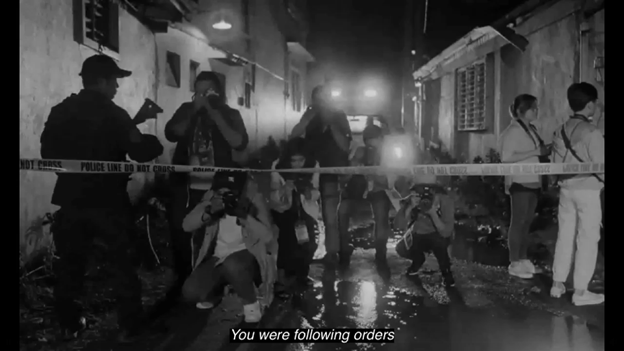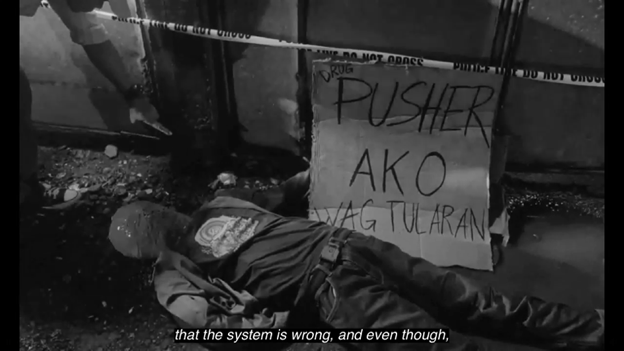by TRIXCY ANNE B. LOSERIAGA
HUMAN RIGHTS are necessary in keeping and protecting a just community. It enforces the laws that give freedom to its citizens to voice out opinions and to defend themselves when charged with baseless accusations.
But under the influence of tyranny and suppression like those uncivilized personnel who carried out extrajudicial killings (EJK) in the country, these rights are oftentimes lost and forgotten.
Kapag Wala Nang Mga Alon, a black-and-white film directed by Lav Diaz, encapsulates the horrors tormenting the victims and the accomplices of their own “culture.”

The narration begins with Hermes (John Lloyd Cruz) teaching cadets, while reminiscing his past missions and life-changing decisions. This scene illustrates the trauma he continues to embody throughout the film. It later manifests itself as a severe disease as he later on can no longer bear the excruciating guilt and anxiety from these events.
Despite the lack of background music, the atmosphere captured the audience’s attention through its element of surprise that foreshadows a character’s fate. One instance is the scene where Primo (Ronnie Lazaro) suddenly visits Nerissa (Shamaine Buencamino) in her farm which turns into a grave later on.
However, there were some mundane scenes cloaked underneath the pretense of comedic relief. An example is the overused cock jokes illustrated by Primo to stretch out his antics.
Culture of fear
The film bounces back and forth from different perspectives between criminals and their victims.
Despite their differences, they all suffer the same fate: inequality in the eyes of society. They are unable to voice out their rights until they are either dead or shunned by society. Scenes such as Raffy (Don Melvin Boongaling) sharing his insights and photos of the recent EJK victims to Hermes portray the anarchic system.
Journalists like Raffy are seen as activists. They are getting threats and corrupt citizens are spreading malicious lies about their work and personal lives. It is portrayed in a scene where several journalists are considering quitting their jobs as it already takes a heavy toll on them, especially with the recent crime rate. Raffy is no exception to this atrocious treatment.
But the scene where Hermes had a toast with Raffy, while saying “To fear and to courage,” signifies a never-ending fight for equal justice and the society’s sentiments on the brutal killings that is continuously happening.
Although the film was able to emphasize its message, there are still improvements that can be made in the technical side, especially with its lighting and character positioning. Scenes such as the media taking pictures of recent EJK victims and Hermes revealing his sickness to Raffy were unfortunately sandwiched between mundane speeches and murky set up.
Systemic injustice
The police are also portrayed as blind dogs in the story—killing countless innocent people and leaving them with placards saying: I am a drug pusher. While they claim that these people are allegedly involved in drugs, the notion stands that the deceased didn’t have any opportunity to present themselves in court and prove their innocence. But those with power and connections are loitering around the streets—just like Primo exploiting all his resources to hunt Hermes down.
Hermes is no exception to this system as he experienced this “culture of death” first-hand. He suffers a skin disease and is discriminated against by society as atonement for his sins. Even his closest loved ones are avoiding him because of this and his past.
As the film reaches its denouement, Hermes and Primo were revealed to be two sides of the same coin—the government. Hermes is performing his duties while Primo abuses his connections to achieve his desires.
Hermes’ guilt is eating him alive that he simply wants to end it all with Primo. Meanwhile, Primo’s infatuation manifests itself through his victims that he labels “lamb” before sacrificing them to his god, Jehovah. He also recounts his past relation with Hermes to a bunch of naked drunk women. Those scenes illustrate their detachment from reality and slowly pushes them to insanity.

Waves of the dead
The usage of water in Primo’s scenes foreshadows the inevitable demise of those who come in contact with a large amount of water. One instance is the death of a pimp in the hands of Primo, which is shortly followed by one of his comedic antics.
The waves also signify Hermes’ emotional state as he lurks within his hometown and Halya city. Its strength amounts to the guilt swelling within himself.
As the film reaches its end, the waves slowly calm down as if releasing the shackles of guilt and anxiety that Hermes embodies. It also serves as Hermes and Primo’s final spectator with Primo screaming “Fuck Philippines! This fuck up country cradling criminals like us!”
Overall, Kapag Wala Nang Mga Alon provided a good depiction of society’s agony although it needs to lessen the unnecessary farce disrupting the characters’ emotional build up. To note, suspected drug pushers dropped like flies during the time of former president Rodrigo Duterte while government critics were forced to either cower in fear or to fight while being named a communist. Unfortunately, there was no comic relief during those episodes. F



